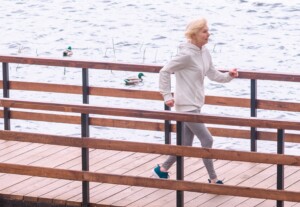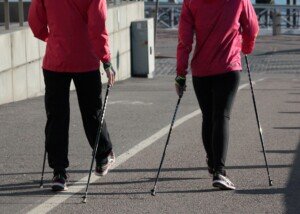
The use of walking sticks, including among older women, seems like more of a fad or gimmick than an orthopedic necessity.
As a former personal trainer, I’m opposed to the use of walking sticks (hiking poles) by an otherwise able-bodied person, including older women.
First off, use of the sticks (touching them to the ground when walking) will not burn more calories than if you didn’t have them.
Maximum calorie burn comes from the largest muscles of the body doing all the work.
If you use the poles to momentarily support yourself with each stride, this subtracts work from the legs, which have the largest muscle groups.
The only way the walking sticks would burn more calories is if you didn’t let them touch the ground.
That’s because you’d then be carrying the hiking poles in a way that would not give support to your walking.
Besides, not all older women who use walking poles are trying to lose weight, so the weight loss issue isn’t all that relevant.
I have to believe that the “everyone else does it” mentality plays a role in the use of walking sticks.
Many older women use these devices when walking on even, stable terrain. I’ve seen people using these on smooth asphalt park trails.
So this isn’t about needing a stick to prevent falling down a steep scree slope.
So many people use walking sticks that I’m also not willing to assume that all of these people (including young ones) have “bad knees.”

Freepik.com
To improve fitness and mobility, and develop more efficient joints and a more efficient core, you must leave the walking sticks at home.
If you’re an able-bodied woman of mature age, ask yourself if you’ve become psychologically dependent on your walking poles.
Example of the Body’s Ability to Adapt
Years ago when I first began hiking steep hills, I noticed that going down on one side (I’d lead with one leg, facing 45 degrees away from the slope—a safe way to descend) was trickier than the other side.
I wanted to use the “good” side more. I didn’t have hiking sticks.
But I realized that in order to get the tricky side to match the good side, I’d have to spend more time descending on the tricky side.
My leg just didn’t feel as strong or as coordinated as the other when I was descending on the more efficient side.
Next week, same slope, I noticed that the “weak” side was improved. It took only one session, stick-free, to create a training effect, an adaptation to the challenging stimulus. Again, I used the weak side more.
The third time, a week later, the “weak” side was almost as efficient as the other side. After that point, on all subsequent hikes, both sides of my body were equally proficient.
Had I relied upon walking sticks…forget it; I would have descended alright, but would NOT have sparked more efficient neurological factors.
Walking sticks will rob the older woman of the chance to improve her neuromuscular function, her coordination and balance.
If you think you’ll fall without the poles for support, then take on an easier trail. But I must emphasize:
People use these sticks on level, smooth asphalt. The element of fad is at work here.
The best way for an older woman to fitness walk is to pump her arms and move briskly or as briskly as she can.
You will feel empowered without the walking sticks, which remove workload from your core.
 Lorra Garrick is a former personal trainer certified through the American Council on Exercise. At Bally Total Fitness she trained women and men of all ages for fat loss, muscle building, fitness and improved health.
Lorra Garrick is a former personal trainer certified through the American Council on Exercise. At Bally Total Fitness she trained women and men of all ages for fat loss, muscle building, fitness and improved health.
.
























